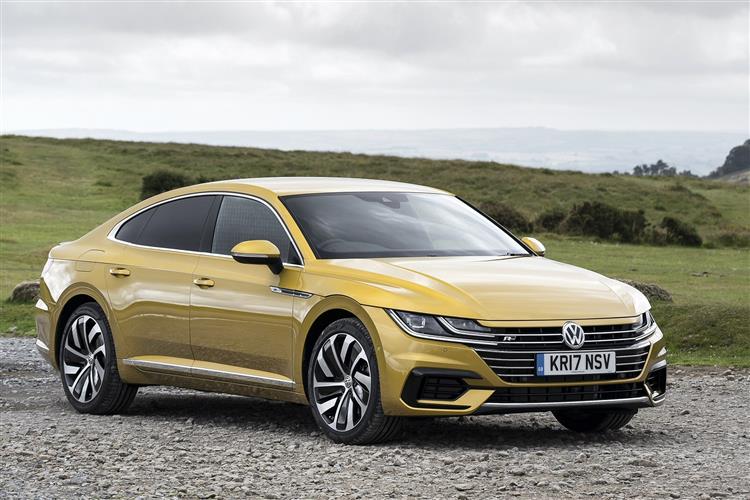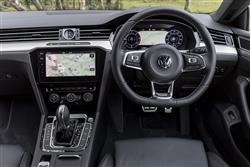ART LESSON (some text hidden) --NONE--
By Jonathan Crouch
Introductionword count: 58
With the Arteon, Volkswagen made another bid for executive segment credibility. Elegance, comfort and technology were all delivered here, along with five-door coupe body styling and a surprising level of practicality. If you're looking for something individual and sensibly different in this sector, it's worth a look. Here, we check out the original 2017-2020-era versions of this car.
Modelsword count: 13
5dr Hatch (1.5 150PS, 2.0 TSI 190PS / 2.0 TDI 150, 190, 240PS)
Historyword count: 544
“Style is about more than just a badge on a boot lid”. Heard that before? Well, it was very much Volkswagen's marketing line with this car, the company's 'Gran Turismo' premium mid-sized executive contender, the Arteon. 'Gran Turismo'? Let's start with that. It's an evocative term the industry likes to use for a four or five-door executive-segment model with sleeker 'coupe-like' 'Fastback' styling. This kind of body shape, much in vogue amongst auto makers in the '60's and '70's, was revived for luxury sector customers by the Mercedes CLS in 2005. Then it was taken up by Volkswagen, who in 2008 created a four-door coupe version of their Passat, the Passat CC, to sell against established prestige brand models like BMW's 3 Series and Audi's A4 in the mid-sized premium segment below. The up-market aspirations of that design became more credible when it was replaced by an updated model in 2011 merely christened the 'Volkswagen CC'. Which is the four-door car that in 2017, this five-door Arteon succeeded in the company's line-up. Cynics will dismiss it as a Passat in a pretty frock. But then so is an Audi A4. All of these models share the MQB platform and engineware used in this period most mid-to-large-sized Volkswagen Group vehicles but in this case, a significant amount of work was put in to differentiate the end result. This was lower, longer, wider and more expansive of wheelbase than the old CC. So much bigger in fact, that if you're going to talk market segments, this Arteon is actually closer in size to a full-sized executive car like an Audi A6 than it is to the kind of Audi A4-sector model it was priced to undercut. This in turn meant that a lot of the engineering here had to be completely bespoke - the braking and suspension systems for example were completely different to those of any other Volkswagen for sale in our market in this period. In short, the Wolfsburg maker's 'Gran Turismo' model was at last in this form, very much its own car. As it needed to be, campaigning in the premium segment with a volume brand badge. Previous to this, the last time the company had launched a flagship luxury model with four passenger doors tasked with doing that was with the Phaeton back in 2003 and that car was almost universally ignored by potential buyers. Back in 2017 though, Volkswagen was optimistic that with the far more stylish Arteon, things would be different. It was aimed at the more accessible mainstream business market rather than the boardroom sector for a start, and was priced directly against competitive premium brand five-door contenders that also featured a similar 'Fastback' 'GT'-style look, cars like Audi's A5 Sportback and BMW's 4 Series Gran Coupe. Like other rivals, these two couldn't match the Arteon for interior space or boot capacity. And they struggled to better this Volkswagen when it came to media connectivity and safety technology too. Despite all of this, sales of the Arteon in its original form were rather slow, but picked up a bit when the car was facelifted and updated at the end of 2020. Here though, we're going to check out the original 2017-2020-era models from a used car buyers perspective.
What You Getword count: 517
Only the five-door hatch 'Fastback' body shape was offered to buyers of the pre-facelifted 2017-2020-era version of this car. This Arteon ushered in a whole new styling era for its brand and its broad, deep grille was subsequently replicated an awful lot on subsequent models, the widest to ever feature on one of the Wolfsburg maker's cars. Its upper cross bars flow into stylised LED headlamps, while simultaneously using finely integrated LED light conductors to perform the functions of daytime running lights. Move to the side and the size and character of the Arteon become even more evident. Ignore any ignorant friends and colleagues who dismiss it as a 'prettified Passat': this is a quite different kind of car with quite different dimensions that see it measure in 95mm longer, 39mm wider and 26mm lower than its showroom stablemate. Those dimensions are almost - but not quite - enough to qualify the Arteon for full-sized executive segment status or, to put it another way, make it an Audi A6 rather than an Audi A4 rival. It's the shaping though, rather than the size, that really sets this design apart. Particularly the swept-back roof line and the 'uplighter' effect of the sculpted lower panels. Inside, a little disappointingly, there's far less evidence of fundamental design differentiation from any ordinary mid-level Manager's company Passat. It says much for that humbler model that this isn't the issue it would be with other volume brands, with high quality materials much in evidence, build quality from the German factory faultless and the overall ambiance very much of a premium standard thanks to the Arteon's classier trimming. As on a Passat, the main thing that catches your eye is the long, slim mid-level chrome-finned air vent, intended in this case to be a visual reference to the cross-bars of the front grille. It extends across the entire width of the interior like a band, interrupted only by the instruments and a smart analogue clock in the centre of the fascia. We mentioned the instruments: they're actually virtual dials. This car got as standard an 'Active Info Display', a 12.3-inch TFT screen that completely replaces the usual conventional gauges with an almost infinitely customisable layout of crystal clear virtual graphics. And the rear? Well, the Wolfsburg brand quotes a legroom figure of 1,016mm, which matches what you'd get from full-sized Executive saloons from the next class up measuring over five metres. As for the swept-back roof, well it doesn't compromise headroom too much - there's 940mm of it - though lankier six-footers may find themselves brushing the smart headliner. Let's finish this segment by taking a look in the boot. Your sales person may well be keen to reference the fact that the 563-litre space provided here is a significant 83-litres more than you get in rival Audi A5 Sportback and BMW 4 Series Gran Coupe models. If you need more room than that, pushing forwards the 60:40-split seatback frees up as much as 1,557-litres of total fresh air and more than two metres of loading length between the front seats and boot lip.
To see the full road test text contact us on 0330 0020 227
Pictures (high res disabled)

.jpg)
|
.jpg)
|
.jpg)
| |||
.jpg)
|
.jpg)
|
.jpg)
| |||
.jpg)
|
.jpg)
|

|
Scoring (subset of scores)
Category: Luxury Saloons and Estates
| Performance | |
| Handling | |
| Comfort | |
| Space | |
| Styling, Build, Value, Equipment, Depreciation, Handling, Insurance and Total scores are available with our full data feed. | |



